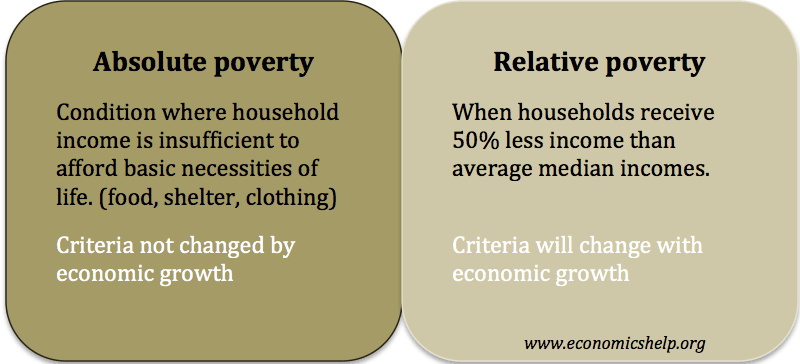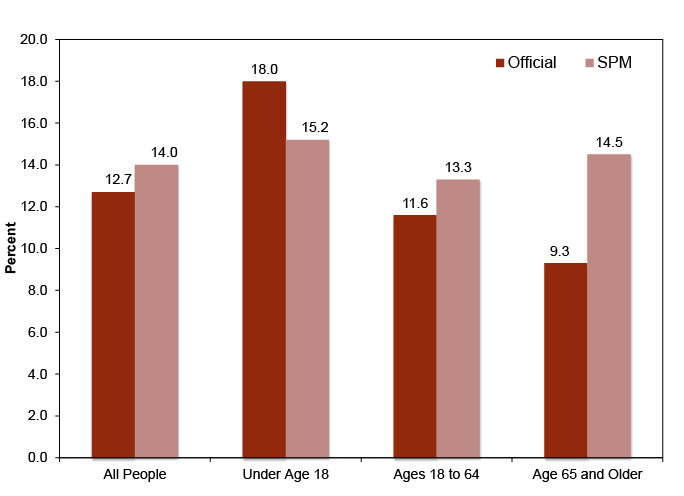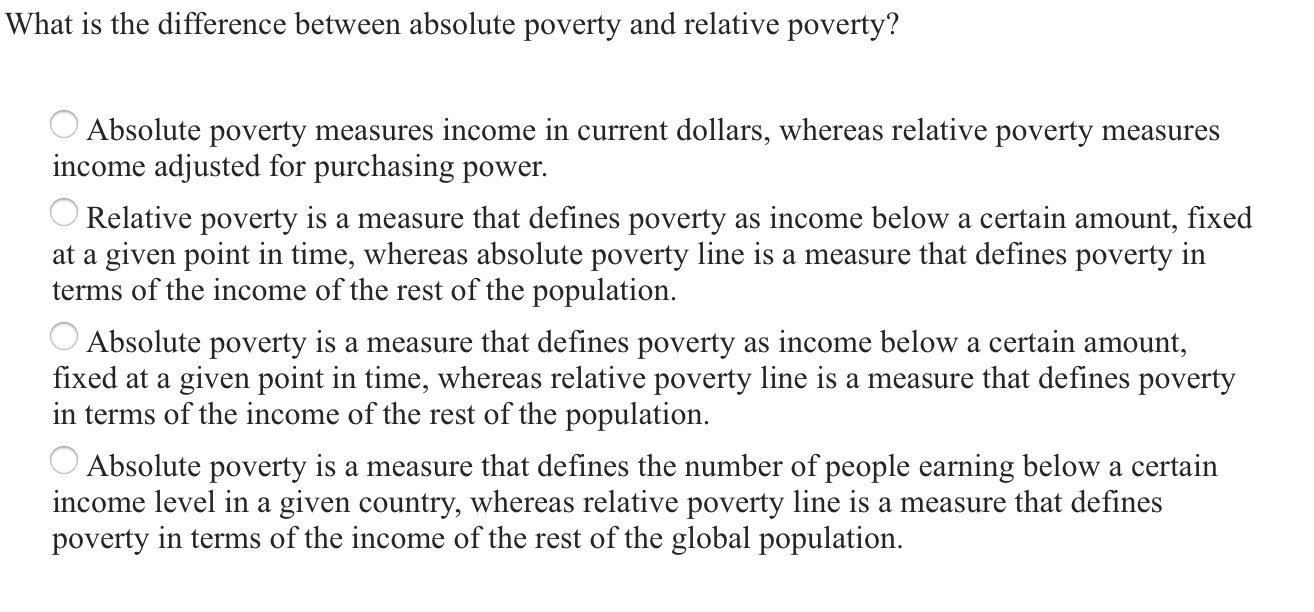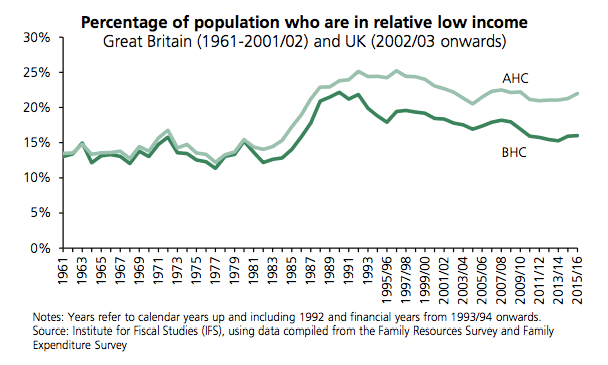Poverty is an economic condition where humans experience a lack of certain commodities essential for stable living. It is possible to identify certain points since 2010 and certain definitions of the poverty measure that show a.

Poverty Inequality And Development Ppt Video Online Download
3

Definition Of Absolute And Relative Poverty Economics Help
Poverty in Africa like elsewhere is typically measured in economic terms.

Absolute measure of poverty. Just over 900 million people globally lived under this line in 2012 based on the latest available data and we project that in 2015 just over 700 million are living in extreme poverty. Hence it is a measure of income inequality. Relative poverty is used to help measure the level of poverty in each individual country.
A relative measure of poverty moves away from measuring the share of individuals facing absolute deprivation and seeks to measure the share of individuals who are unable to fully participate in society. But as weve mentioned economics cannot be the sole measure and determinant of poverty. Absolute Poverty.
Rather these scholars believe that a relative poverty measure is more appropriate defining the poverty threshold at 50 percent of a countrys median income for example. Poverty is the state of having little material possessions or incomePoverty can have diverse social economic and political causes and effects. Absolute Poverty and Relative Poverty are two terms used to measure this poverty level.
Absolute poverty measures compare income against the amount needed to meet basic personal needs such as food clothing and shelter. Despite its shortcomings measuring poverty using an absolute measure allows for the possibility of progress in reducing it. It is defined from the social perspective that is living standard compared to the economic standards of population living in surroundings.
The new global poverty line is set at 190 using 2011 prices. While important in itself the qualitative data can also provide a helpful check on the robustness of lessons. The Social Metrics Commission data does not measure either of these.
Of who is poorer than who rather than an absolute measure of poverty against a fixed benchmark. Absolute poverty is when a person cannot afford the minimum nutrition. Absolute poverty is the condition in which a person does not earn the minimum amount of income to cover their minimum requirements as a human being over an extended period of time.
For instance someone in the US would have to earn less than 13000 per year to fall into relative poverty. When evaluating poverty in statistics or economics there are two main measures. Real income of 500 per year.
Relative poverty is defined relative to the. Using a relative measure of poverty does not since there will always be a lowest 15 or 110 of the population. The international poverty line currently set at 190 a day is the universal standard for measuring global poverty.
Since this approach to measure absolute poverty is concerned with counting the number of persons or heads this is generally referred to as Head-Count Ratio approach to measure absolute poverty. People in relative low income living in households with income below 60 of the median in that year. This is to distinguish a uniform measure of poverty throughout the world and identify serious cases of poverty.
The international poverty line is designed to stay constant over time to allow comparisons between different years. The main measure of relative poverty shows as many as 14 million people in povertythis new measure has it at 143 million due to this choice. Poverty projections suggest that the social and economic impacts of the crisis are likely to be quite significant.
Changing that threshold makes a stark difference toousing the previous years figures if you made it 50 youd have moved 25 million people out of poverty. Poverty is in large measure a relative concept. Absolute poverty could be set at a constant real income level eg.
In 1974 in response to a Congressional requirement an interagency Poverty Studies Task Force was established to undertake an intensive review of the current poverty measure and alternative measurement schemes. However it would have to take into account different living standards between countries. To measure whether poverty is absolute or relative you first have to construct thresholds and collate data to calculate the overall number of people who could be considered poor.
The claim specifically mentioned absolute poverty and relative poverty. The standard measure is the World Banks definition of living on less than 190 per day. Estimates based on growth projections from the June 2020 Global Economic Prospects report show that when compared with pre-crisis forecasts COVID-19 could push 71 million people into extreme poverty in 2020 under the baseline scenario and 100 million under the downside scenario.
In order to measure absolute poverty amongst children it is necessary to define the threshold measures of severe deprivation of basic human needfor. Recognizing the trade-offs researchers are now seeking compromises by integrating qualitative and quantitative indicators into their analyses. It is also not designed to capture how people view their own financial situation known as the socially subjective poverty line.
Two commonly used measures are. 2020 Median household income in 2020 decreased 29 between 2019 and 2020 and. This line helps measure the number of people living in extreme poverty and.
If N stands for the number of population H for the number of persons having consumption expenditure or income below that then head-count ratio of absolute poverty can be written as. Then when a relative approach is used a changeable level of what households should be able to rely on in order to meet their basic needs is set and anyone who falls below that is counted in this category. The UN summit on poverty called for countries to develop their own measure.
To do so it uses two main measures the official poverty measure and the Supplemental Poverty Measure both of which are described in this FAQ. Income Poverty and Health Insurance Coverage in the US. Relative poverty is considered the easiest way to measure the level of poverty in an individual country.
What is the new poverty line and based on this new measure how many people are living in extreme poverty in the world. It is therefore a measure of absolute poverty and is not measuring relative poverty. But relative measures do make an important point.
No changes were made in the poverty definition as a result of the 1973 review of poverty and income statistics. The World Bank uses absolute poverty as its default definition of poverty. Official Poverty Measure The Census Bureau determines poverty status by using an official poverty measure OPM that compares pre-tax cash income against a threshold that is set at three times the cost of a minimum food diet in 1963 and.
500 would be insufficient to gain shelter in New York but maybe in Africa. Absolute poverty is a measure of whether the incomes of the poorest households are keeping pace with inflation and is based on a fixed poverty threshold the inflation-adjusted relative poverty threshold in 201011. Absolute Poverty is used to describe a condition where an individual does not have the financial means to obtain commodities to sustain life.
Various poverty measures based on disposable household income are in common use and the trend can look quite different depending on the measure used. Absolute poverty rate for all individuals stable.

How Is Poverty Measured Institute For Research On Poverty Uw Madison

Solved What Are The Two Main Ways To Measure Poverty O Chegg Com

Definition Of Absolute And Relative Poverty Economics Help

How Should We Measure The Poverty Rate Lane Kenworthy
3

Relative Vs Absolute Poverty Defining Different Types Of Poverty

Poverty Measure An Overview Sciencedirect Topics
:max_bytes(150000):strip_icc()/Poverty2018Final-b00e22ebb1e146baa8028d834b593a73.jpg)
Poverty Definition
- Contoh Tutup Akaun Saham Peladang
- Blue In Japanese
- Kenzo Lee Hounsou
- K On Anime
- Donkey Kong Levels
- Fi Pendaftaran Pindahmilik Seberang Perai Utara Pulau Pinang
- Pelakon Lelaki Mohabbatein
- Akaun Bank Kena Freeze
- Semak Nombo Akaun Report Polis
- Food And Beverage Meaning
- Hospital Seberang Jaya
- Dylan Wang And Shen Yue
- Ejaan Betul Yang Dipertua
- Harvey Norman Shah Alam
- Aktiviti Kemasyarakatan Yang Dilakukan
- Bahan Aktif Kapur Barus Jenazah
- Bibliografi Kajian Tindakan
- Goku And Vegeta Fusion
- Just Cause 3
- How To Delete Albums On Iphone
